
GEORGE FORTY
WORLD WAR TWO. ARMOURED FIGHTING VEHICLES & SELF-PROPELLED ARTILLERY
The Lynx scout car, built by the Ford Motor Company of Canada, was the Canadian version of the Daimler Dingo, but was slightly larger (1ft 8½ins longer) and 2240lbs heavier. It was powered by a 95hp Ford V8 petrol engine, which gave the vehicle a top speed of 57mph and a range of 200 miles. Armour on the Mk I was 30mm and it had an armoured folding root. Its dimensions were: 12ft 1in long, 6ft 1in wide and 5ft 10ins high. The Lynx Mk I was followed by the Mk II which had various modifications, including: no folding roof, strengthened springs and axles, sand channels carried across the rear (adding some 7ins to the length), Canada built over 3,000 Lynx during the war. In addition to the Lynx Mk I ft II, there was an SP artillery version, which had a 2 pounder anti-tank gun with a shield, located in the front of the Lynx body adding to its length (overall 11ft 8ins). Finally, there was the Scout Car Mk III & III*, which resembled the Lynx, built by Marmon-Herrington in the United States for Canada.
Light Reconnaissance Car Mk I Otter I was the Canadian produced version of the Humber Mk III light reconnaissance car, using mainly Canadian components and a 104hp General Motors petrol engine. Weighing 4.8 tons, the three man Otter was 14ft 9ins long, 7ft wide and 8ft high. Over 1,700 were built and used mainly by Canadian troops in Italy, although some were supplied to the British Army and the RAF Regiment. A second version had the turret replaced by a low, bevelled shield, and was armed with a .50in Browning and a smoke mortar.
Two hundred Fox Mk I armoured cars were built by General Motors of Canada. This was the Canadian version of the Humber Mk III armoured car, armed with both a heavy and light Browning machine gun (.50in and .30in) instead of BFSA machine guns. Dimensions were: 15ft long, 7ft 5½ins wide and 8ft 1in high. There was also a Fox Mk II which was based on the Humber Mk IV. As with the Lynx, there was also an SP artillery version, this one mounting a 6 pounder gun on a Fox Mk I chassis, in a box-like hull which was higher in front than at the rear.
Armoured Personnel Carrier GM, known also as the Truck Armoured 15cwt 4×4 GM was a small APC (only 15ft 7ins long, 7ft 6ins wide and 7ft 5ins high) with a box like hull, raised over the driving position, open topped and had tarpaulin covered bows. On the same chassis there was an armoured ambulance which had a slightly higher hull (8ft 1½ins) and a convoy escort vehicle which was very similar to the APC, but the rear of the hull was lower.
In addition there were a number of other AFVs including: CAPLAD - British designed, Canadian-built general purpose vehicle which resembled a Fox Mk I. but without a turret. It took its name from the initials of its various intended roles: Command, Armoured Personnel, Light Aid Detachment. Development work also took place in Britain, and between 1943 and 1944 pilot models were built in both countries. However, it was really too small for use as an APC, while interest in the Command element shifted to building proper ACVs. The CAPLAD project was cancelled.
Another vehicle was based on a Canadian Ford type-AA lorry and mounted either quadruple 20mm Polsten cannons, or a partially shielded 40mm Bofors.
The Windsor was produced in large numbers by the Ford Motor Company of Windsor, Ontario. Although the Windsor incorporated many of the Lloyd Carrier components, its design was based on the Universal Carrier. Unfortunately, some mechanical problems were discovered after the design had been approved and the agreed production of 500 a month had begun in 1943 Rectifying these faults slowed production considerably, consequently only small numbers entered service before the war ended. However, it was used in North West Europe to tow the 6 pounder anti-tank gun. An has already been mentioned in Chapter One, various models of the Universal Carrier were built in Canada (Canadian vehicles had the prefix CT rather than the normal T), as were various Medium Machine Gun Carriers (MMGC).

Canadian built (and manned) Universal Carrier, towing a 6 pounder anti-tank gun. The numerals '46' denote that it is from an anti-tank regiment of an infantry division, June 1944. (TM)

A General Motors of Canada Mk I Fox armoured car, without its armament fitted (.50 and .30in Browning MGs). (TM)
As also mentioned in Chapter One, the Ronson flamethrower had not been accepted for service with the British Army, but was accepted by the Canadians. Some of these Ronson devices were sent to the Pacific theatre for use in US Marine Corps M3A1 light tanks (Ronson was know n as Satan by the Americans), Development continued in Canada and the Wasp Mk IIC - also known as the FT Transportable No 2 Mk IIC - was developed for the Canadian Army (hence the C for Canada). The main difference to the Wasp Mk II was that only one flame fuel container (75gallons) was carried and mounted on the outside of the earner at the rear. This meant there was room, for a third crew man inside the vehicle, who could fire a Bren gun or a 2-inch mortar. The flamegun was still the same and was mounted as for the Mk II. This allowed the carrier to be used for two roles and not just flamethrowing. Operational use in North West Europe proved that this solution was the best and all production in Britain was changed to allow for dual capability. Sometimes plastic armour was fitted to the carrier front for increased protection.
Just as the. American M7 Priest was a self- propelled artillery version of the M3 medium tank, so the Sexton was a similar self-propelled artillery version of the Ram medium tank, but with the British designed 25 pounder gun in place of the American 105mm. The Sexton was developed in the latter half of 1942, motivated by the way in which the Germans managed to produce self-propelled artillery to support their Afrika Korps infantry. It was based on the Ram chassis, with the howitzer mounted in a central position and the driver located on the right. In order to achieve sufficient elevation, recoil had to be limited.
The pilot model was built by the Montreal Locomotive Works, shipped to Britain for trials and once approved, production began at Montreal in early 1943, By the end of that year, over 420 had been built. Additional orders continued production right up to the end of the war, by which time 2,150 Sextons had been built. Some changes were made during production to incorporate improvements from the American Sherman, such as a one-piece cast nose, towing hook for an ammunition trailer, an auxiliary generator and mountings for Bren AA guns. As Sextons were produced they began to replace Priests in the field regiments of armoured divisions.
Specifications
Weight(tons) 25.45ton
Crew six (Commander, gunner, gun-layer, loader, wireless operator and driver)
Dimensions:
Length 20ft 1in
Width 9ft
Height 8ft
Armament 25 pounder howitzer Mk II and two Bren guns
Armour 12-25mm
Engine 400hp Wright R-975 air-cooled radial
Max speed 25mph
Range 135miles
Ammunition 105rounds (HE, Smoke and stowed AP) 50 Bren magazines

Two Canadian GM Mk I Otter light reconnaissance cars, which were the Canadian version of the British Humber Mk III, here in service with the RAF Regiment. (TM)
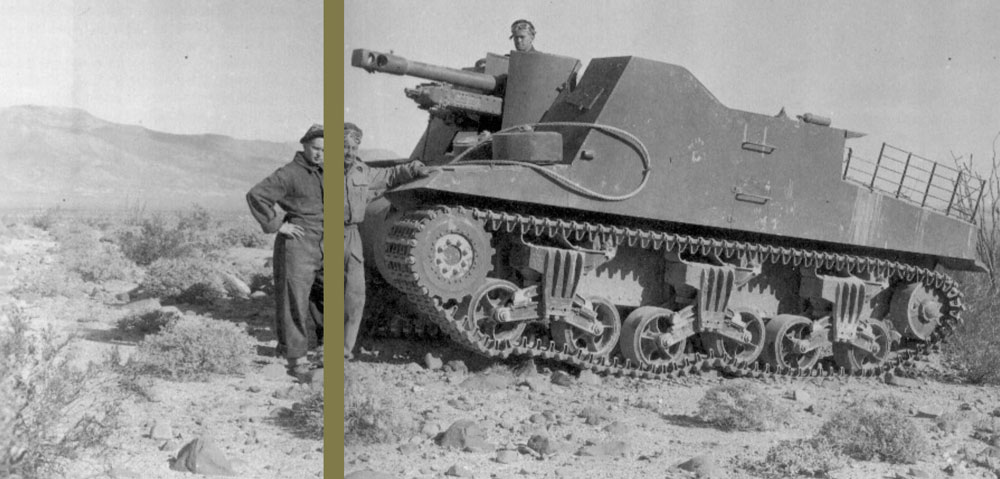
Sexton was the self-propelled gun version of the Ram medium tank. It mounted the British-designed 25 pounder. (TM)

The Australian-built 4×4 scout car had a crew of two. The body had vertical sides and a sharply sloping rear deck. (TM)
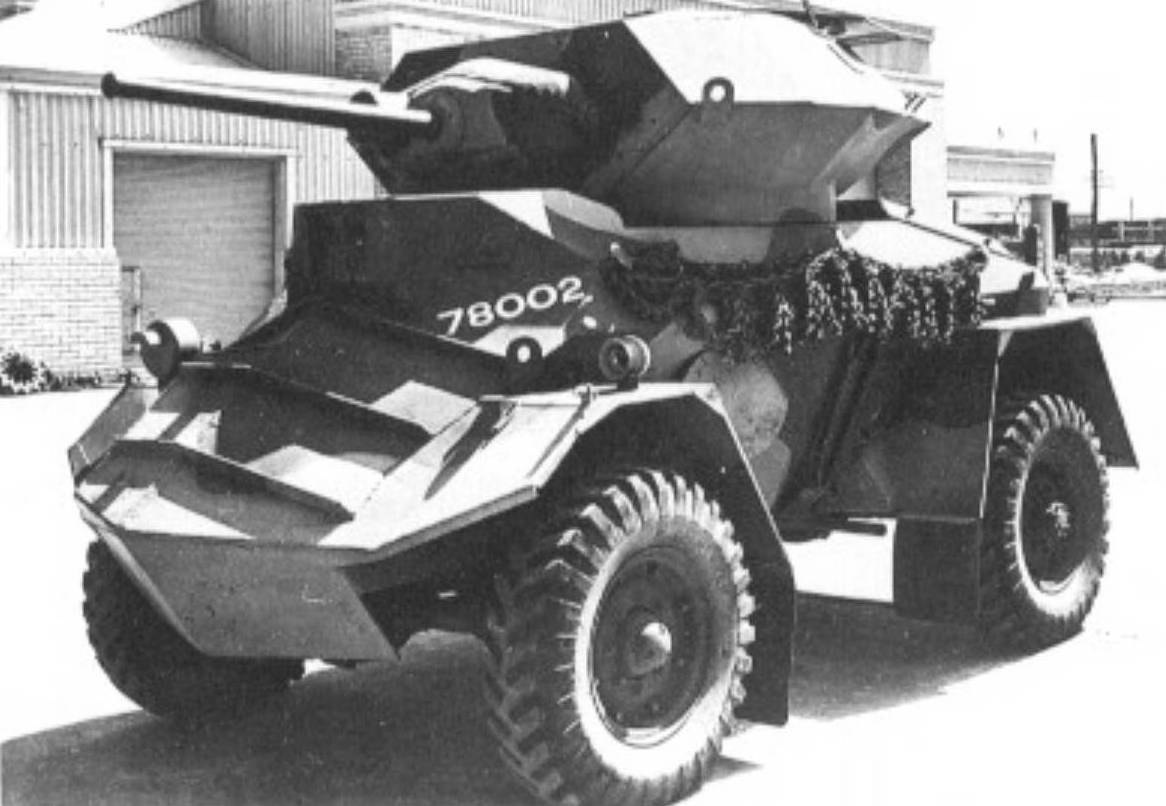
The Australian Rhino armoured car of 1943 mounted a 2 pounder gun in a Crusader-type turret. (TM)
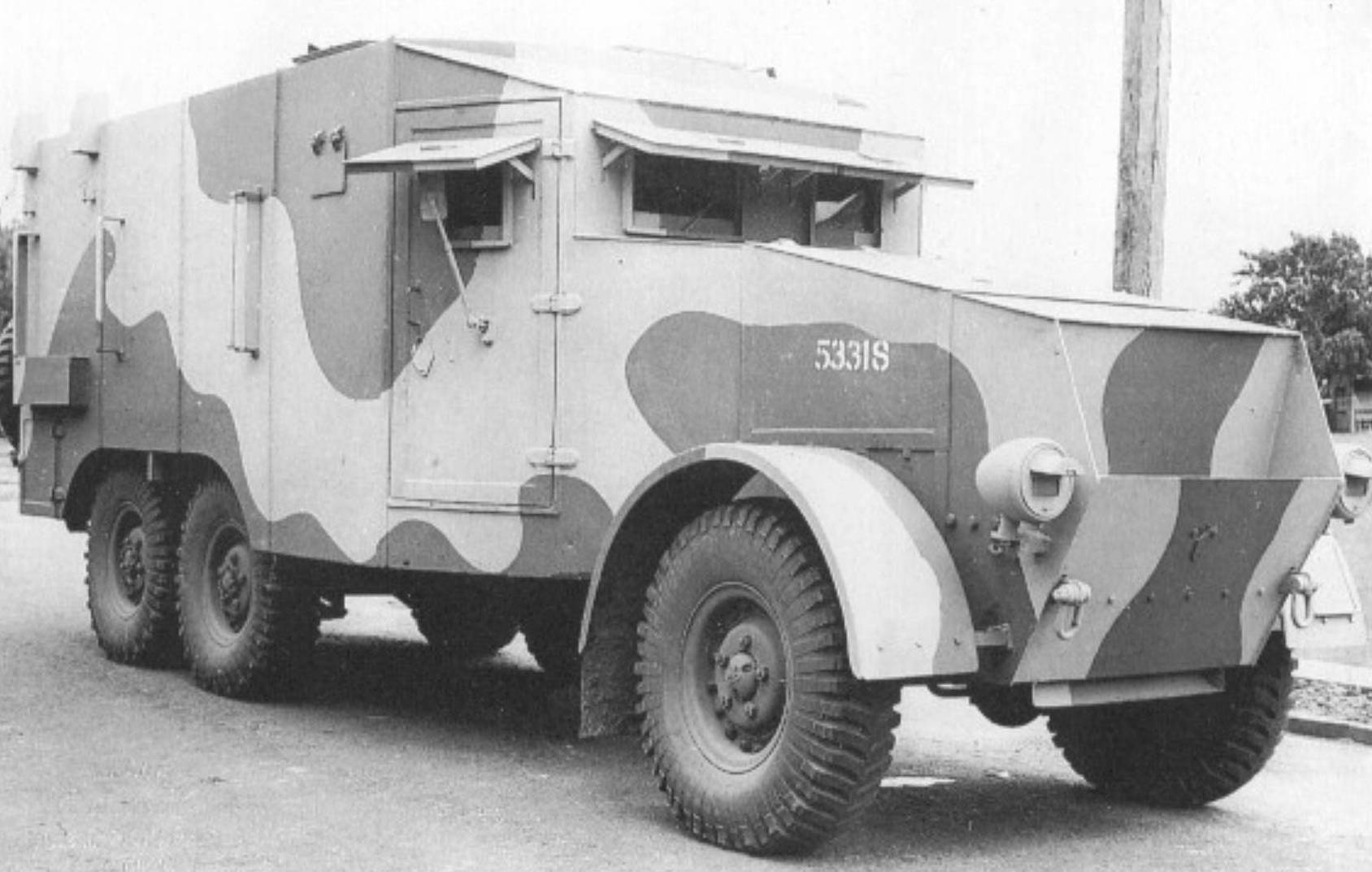
An Australian-built 6×6 Ford/Marmon-Herrington armoured command vehicle (ACV). (TM)

Australian-built Universal Carriers training in the Malayan jungle, before the Japanese invasion in 1941. (TM)
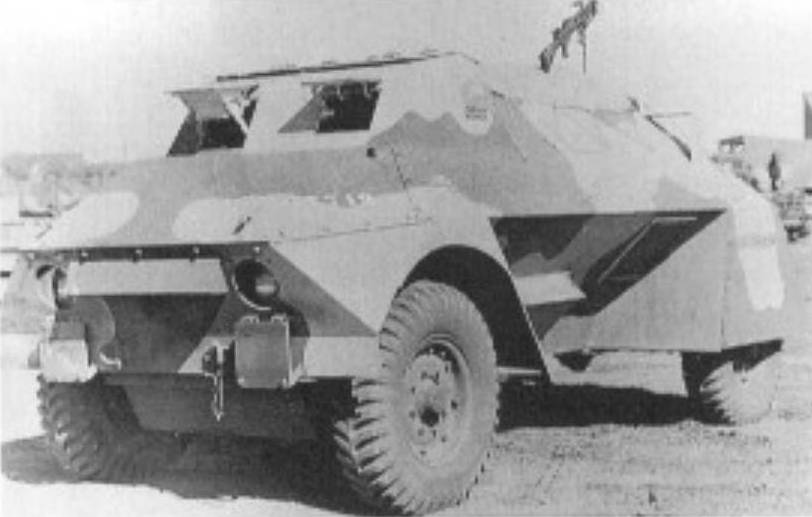
The turretless Rover Car was built in Australia during 1943. (TM)
Apart from producing a few experimental AFVs in the late 1930s, Australia had little experience of building armoured vehicles. Nevertheless, having appreciated that Britain would be unlikely to be able to till their requirements they took on the task with enthusiasm and produced two scout cars and one armoured car between 1942 and 1943. The first Scout Car, built in 1942, was a simply-designed turretless 4×4 car with a crew of two. The sides were vertical and the back decking sloped quite sharply. The car was 15ft long, 6ft 10ins wide and 6ft 1in high. The top had an armoured sliding roof.
The second Scout Car was known as the Rover Car and was built in 1943. Again it was turretless and low-profile in design, with an open lop and covered rear wheels. It was 18ft 7ins long (the prototype had been 1ft 6ins longer), 7ft 7ins wide and 7ft high. The armoured car known as Rhino had a body that resembled a Daimler armoured car and a Crusader-like tank turret mounting a 2 pounder gun. There were three prominent diagonal bullet splash deflectors on the front glacis plate.

A line up of New Zealand-built Universal Carriers, ready for despatch. They were initially produced using working drawings and machine tools provided from Australia. (TM)
In addition to these three vehicles, Australia built a troop carrier which was similar to Rhino, with an open-topped hull but without a turret; a Ford/Marmon-Herrington Command Vehicle which was a 6×6 van-type command car; a utility car/cargo vehicle made by converting scout cars for use by American forces in the Pacific. In addition, they modified the US Army White M3 scout car to make a command car, with raised body sides.
Carriers were produced in far greater quantity, with more than 5.000 being built in Australia. They decided to use the British designs and drawings, modified to suit local manufacturing conditions. Various components were made by sub-contractors with the being vehicles assembled in State workshops. Power units were supplied from the United States The resulting carrier was designated Carrier LP (Local Pattern).
New Zealand built two light armoured cars, both known as the Beaverette (NZ) Light Armoured Car. The prototype was like the British Beaverette. but built using the Ford ¾ ton chassis. The production version followed using the Ford 1-ton lorry chassis. A total of 171 were built. They also modified the American designed White M3 in the same way as the Australians, but it was called the White OP truck. In addition, they produced various unarmoured LRDG (Long Range Desert Croup) vehicles, based on the Chevrolet ¾ ton truck, one type mounting Boys anti-tank rifles, Brens and light mortars; another a 6 pounder anti-tank gun, carried portee and firing over the back of the lorry!
New Zealand also followed the Australian lead as far as the production of carriers was concerned, in fact they obtained their drawings from Australia, their Ford engines and other medianical components from Canada. The carriers built were identical to those manufactured in Australia
Various armoured vehicles were produced by India during World War Two. including a versatile range of wheeled carriers, the first being the Armoured Carrier Wheeled India Pattern Mk I which was based on the British Guy universal wheeled carrier. The Mk II, produced in 1942, and all subsequent models were based on the a four-wheel drive chassis which was supplied by the ford Motor Company of Canada. The Mk IIA had larger tyres, the Mk IIC was similar but with wider track, heavier components and a flat glacis with a box for the driver's head. Next came the Mk III, which was similar to the Mk IIB but with a partly covered hull and a small open-topped turret mounting an AA Bren gun.
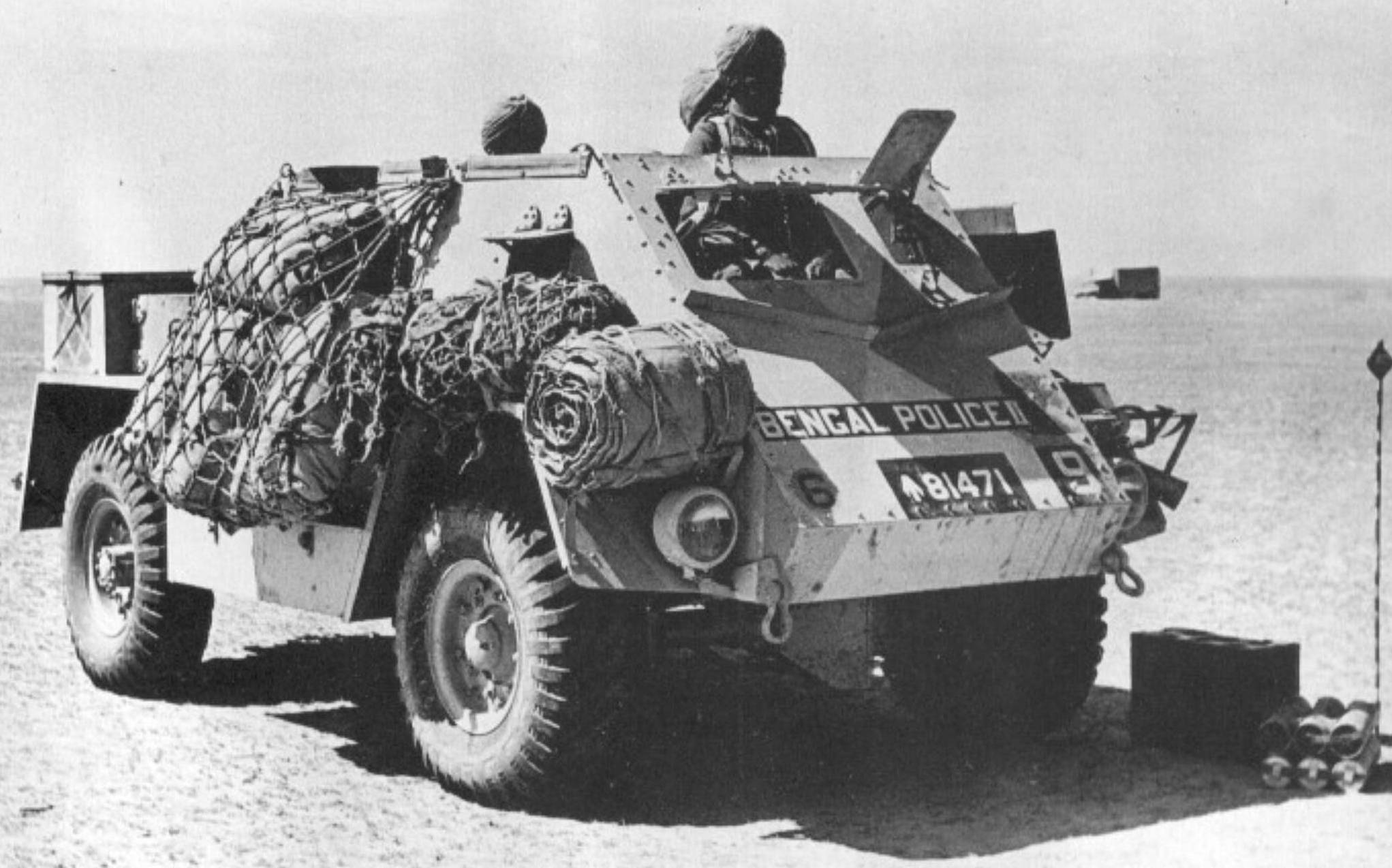
India built a number of good, wheeled armoured carriers, this one is the India Pattern Mk IIA, which was based on a Ford 4×4 chassis supplied from Canada. It mounted a Boys anti-tank rifle and a Bren AA (neither fitted in this photograph). (TM)
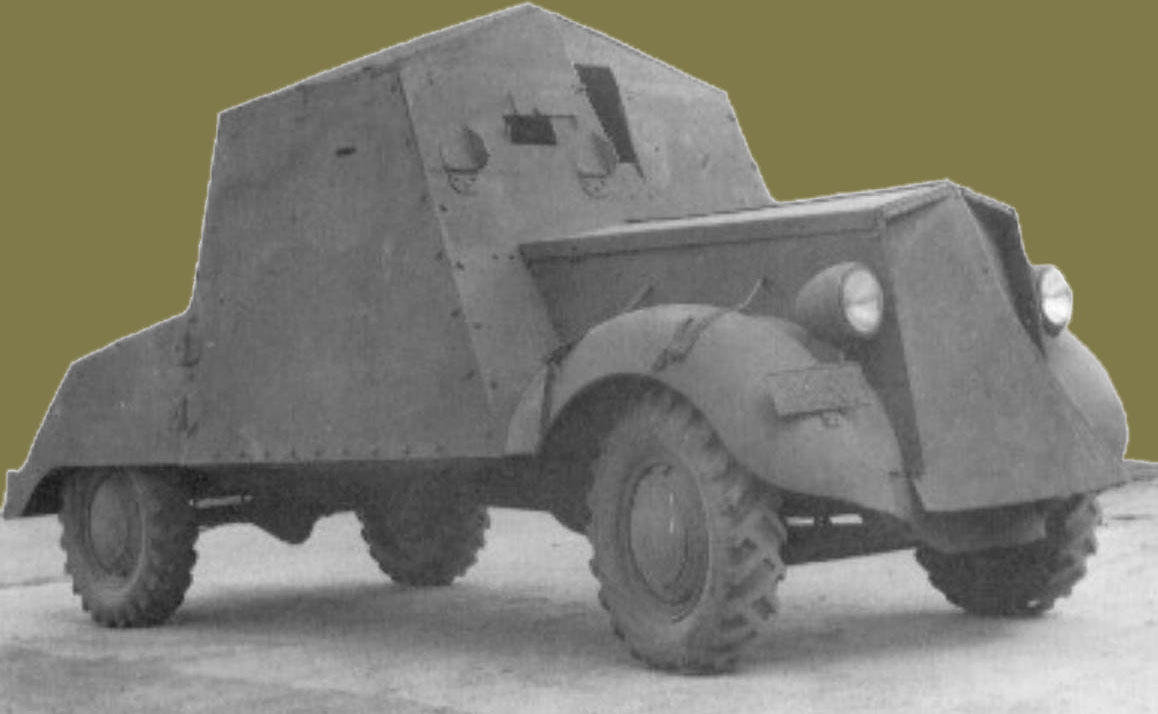
The prototype for New Zealand Beavertte-type vehicle, based on a Ford chassis. (TM)
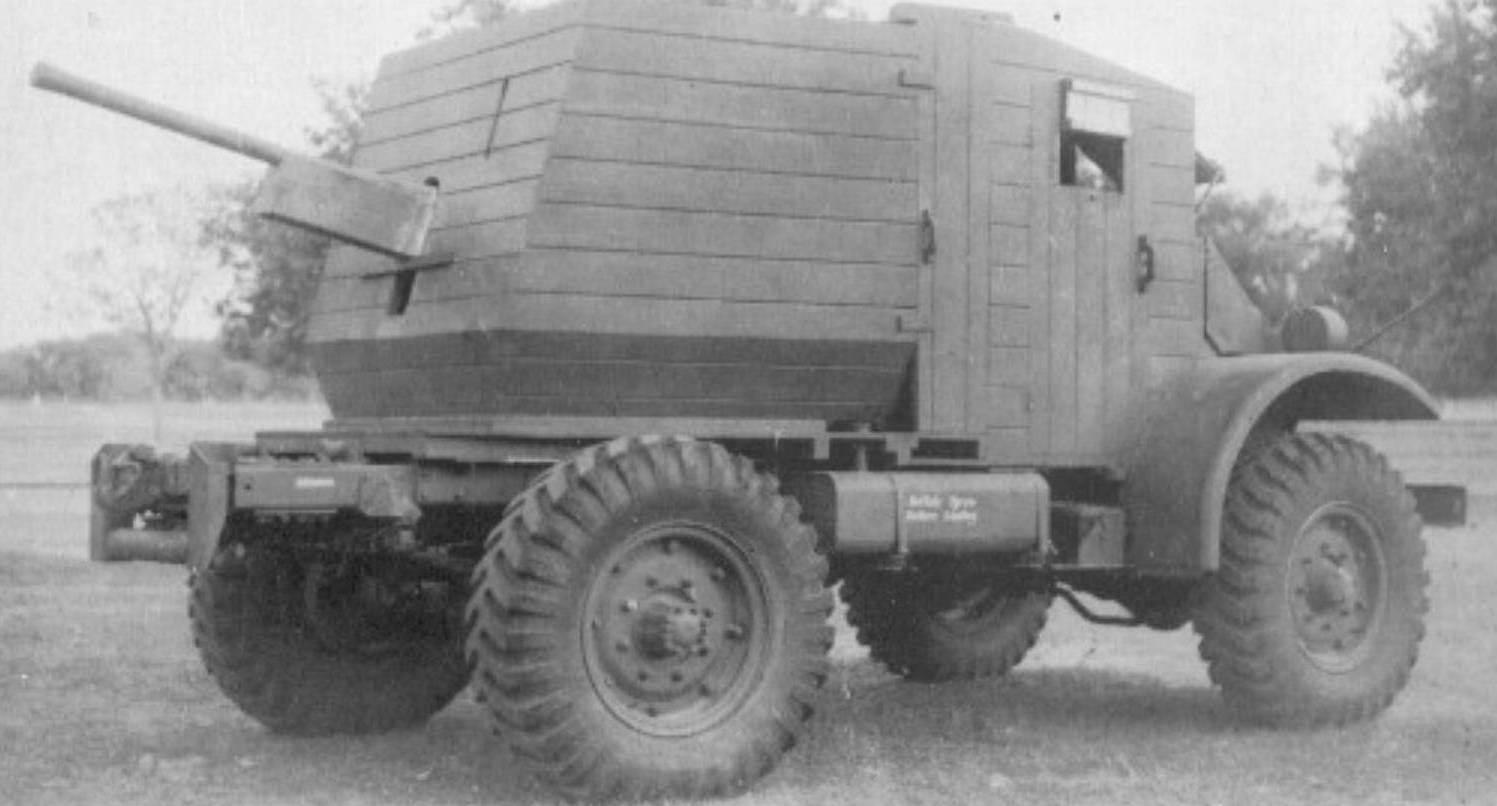
An Indian 2 pounder Borbette Mk II The body appears to be constructed entirely of wood! (TM)
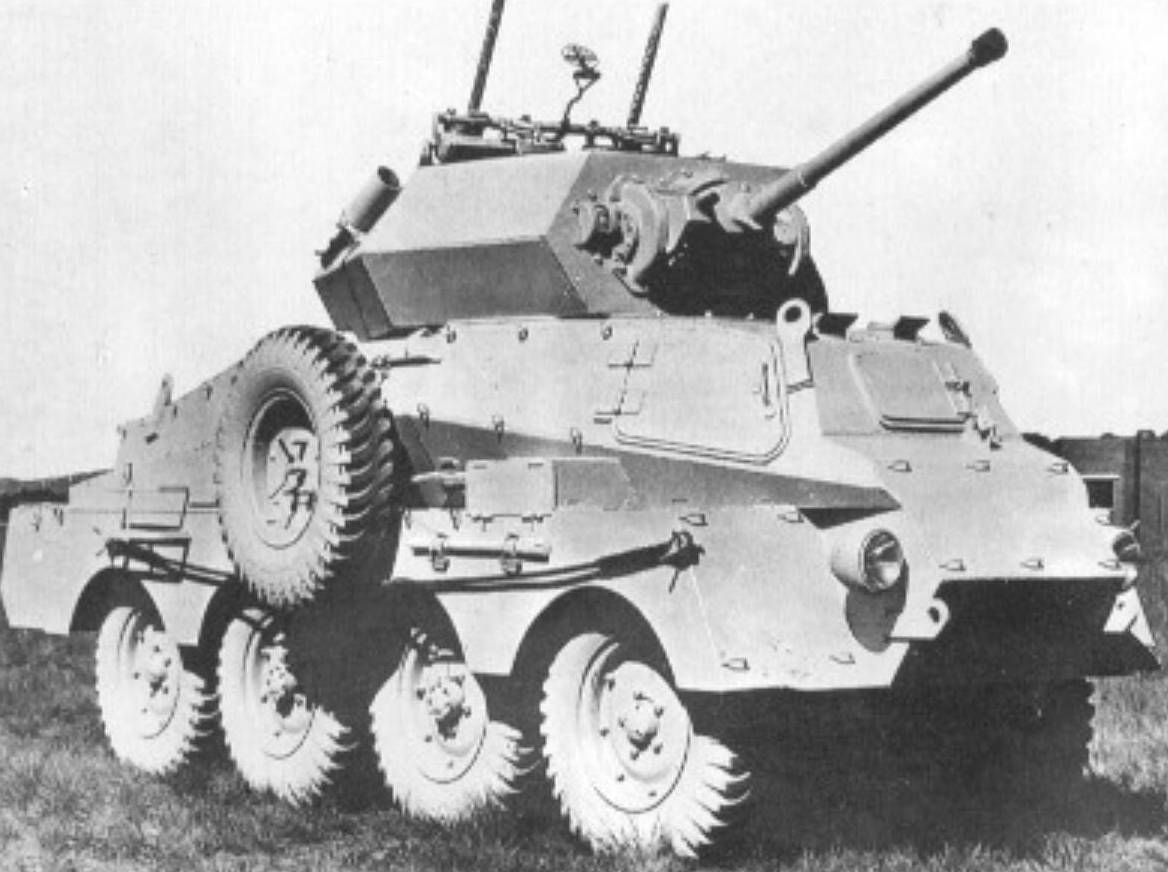
The South African Armoured Reconnaissance Car MkVI (Marmon-Herrington armoured car Mk VI) mounted a 6 pounder instead of a 2 pounder gun. It was first ordered in mid-1942. but then cancelled. (TM)
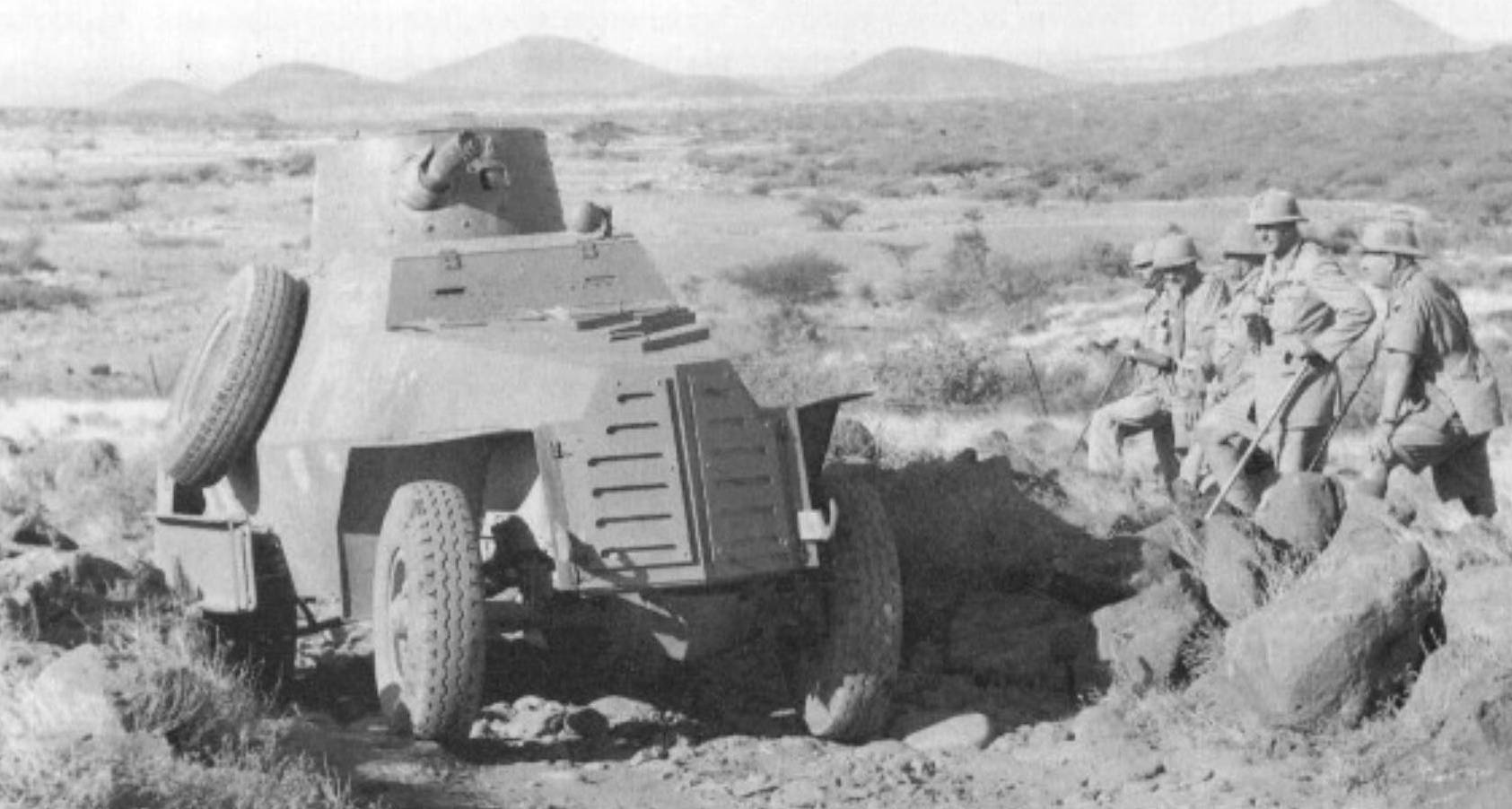
The later version of the Marmon-Herrington Mk II had a welded hull with the side doors fitted further back on the body. This one was photographed in Eritrea, 1940. (TM)
The final model, the Carrier Wheeled 4×4 Mk IV (IP), was similar to the Mk MB, but with an open hull. Its dimensions were: 15ft 2ins long, 7ft 7ins wide and 6ft high. All had similar armament, namely a Boys anti-tank rifle or Bren LMG mounted to the left of the driver and fired through a hinged flap in the front plate. The carrier had a crew of three or four, weighed 5.3tons and was powered by a 95hp Ford V8 engine. The armoured carriers were used in the Middle East, Italy and the Far East.
Produced in 1942, the 4×2 GM (Armoured Observation Vehicle (IP)) built by General Motors, had a box-like armoured body suitable for command, signals and ambulance models.
The Union of South Africa built a series of extremely good armoured cars during World War Two. many of which saw active service in the Western Desert. Although manufactured in South Africa their engines, transmissions and suspensions were imported from the United States, while the machine guns and Boys anti-tank rifles, which formed the main armament of the early models, came from Britain, as did the later installed 2 pounder anti-tank guns. It was the American company Marmon-Herrington, who had entered the armoured car building market in the early 1930s. which initiated the project. As well as bidding for the contract to build the T11 armoured car, they also produced armoured cars for export to Persia and developed a kit of parts for transforming commercial trucks into four-wheel drive vehicles on which could be fitted a variety of armoured bodies. A small number were purchased by the US National Guard and in 1939, the Union of South Africa chose one of their conversion kits as the basis for their new armoured car. This was a Ford 4×2 chassis, powered by a V8 engine and armoured (6-12mm thick) by the South African Iron & Steel Corporation. Known as the Marmon-Herrington Mk I armoured car (also called the South African Reconnaissance Car Mk I), it entered South African service in 1940. It had a crew of four and was armed with two .303in Vickers water- cooled machine guns, one ball mounted in a conical-shaped turret, the other in the left side rear of the hull. It had three very distinctive vee-shaped bullet splash rails on top of the bonnet. Over 100 of these cars were built but only saw service in the Union Defence Forces, none being issued to British units.
We have much more interesting information on this site.
Click MENU to check it out!
∎ cartalana.com© 2009-2025 ∎ mailto: cartalana@cartalana.com